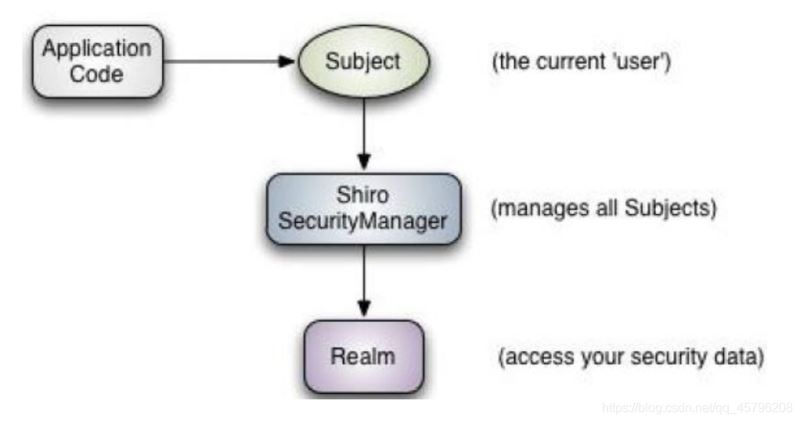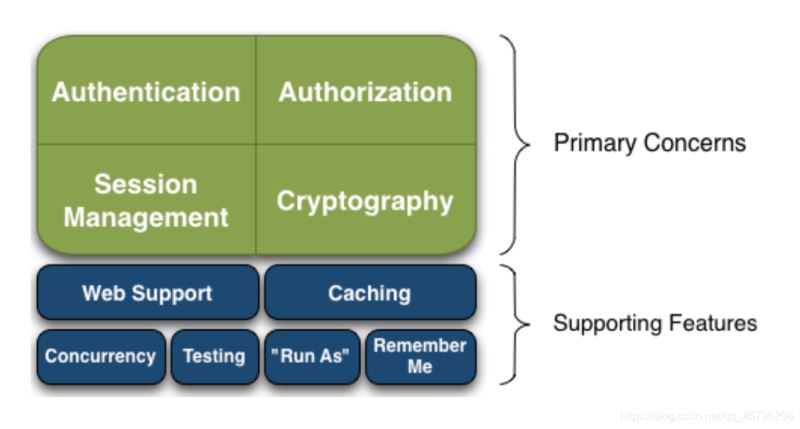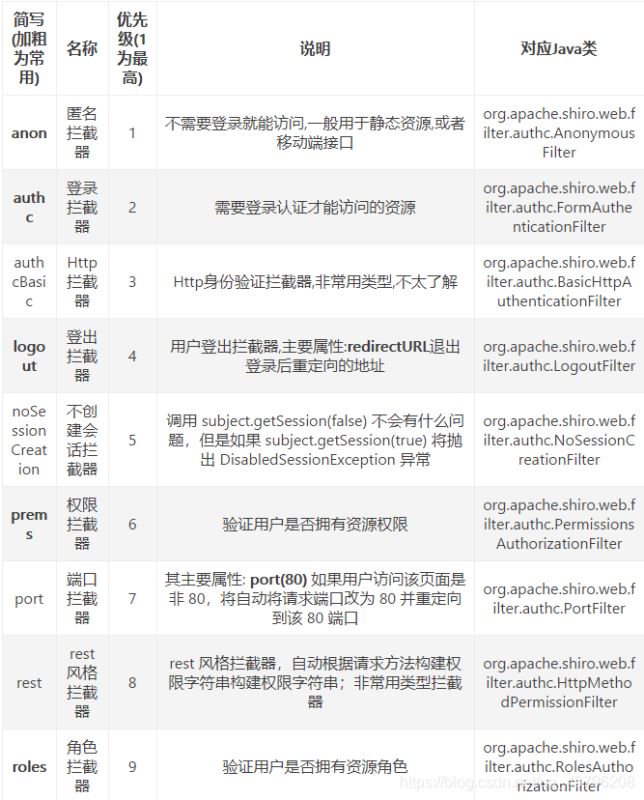目录
- 什么是Shiro
- Shiro的三大核心概念
- Shiro功能介绍
- Springboot整合Shiro
- 导入依赖
- javaConfig
- Realm
- Controller
- Shiro整合thymeleaf
- 导入依赖
- HTML页面命名空间
- 使用举例
- 总结
什么是Shiro
Apache Shiro是一个功能强大且易于使用的Java安全框架,它执行身份验证、授权、加密和会话管理。借助Shiro易于理解的API,您可以快速轻松地保护任何应用程序—从最小的移动应用程序到最大的web和企业应用程序。
Shiro的三大核心概念

Subject:
主体,代表了当前“用户”,这个用户不一定是一个具体的人,与当前应用交互的任何东西都是Subject,如爬虫、机器人等;即一个抽象概念;所有Subject都绑定到SecurityManager,与Subject的所有交互都会委托给SecurityManager;可以把Subject认为是一个门面;SecurityManager才是实际的执行者。
SecurityManager:
安全管理器;即所有与安全有关的操作都会与SecurityManager交互;且它管理着所有Subject;可以看出它是shiro的核心, SecurityManager相当于spring mvc中的dispatcherServlet前端控制器。
Realm:
域,shiro从Realm获取安全数据(如用户、角色、权限),就是说SecurityManager要验证用户身份,那么它需要从Realm获取相应的用户进行比较以确定用户身份是否合法;也需要从Realm得到用户相应的角色/权限进行验证用户是否能进行操作;可以把Realm看成DataSource,即安全数据源。
Shiro功能介绍

Authentication:
身份认证/登录,验证用户是不是拥有相应的身份;
Authorization:
授权,即权限验证,验证某个已认证的用户是否拥有某个权限;即判断用 户是否能进行什么操作,如:验证某个用户是否拥有某个角色。或者细粒度的验证某个用户对某个资源是否具有某个权限
Session Manager:
会话管理,即用户登录后就是一次会话,在没有退出之前,它的所有信息都在会话中;会话可以是普通 JavaSE 环境,也可以是 Web 环境的
Cryptography:
加密,保护数据的安全性,如密码加密存储到数据库,而不是明文存储; Web Support:Web 支持,可以非常容易的集成到Web 环境;
Caching:
缓存,比如用户登录后,其用户信息、拥有的角色/权限不必每次去查,这样可以提高效率;
Concurrency:
Shiro 支持多线程应用的并发验证,即如在一个线程中开启另一个线程,能把权限自动传播过去;
Testing:
提供测试支持;
Run As:
允许一个用户假装为另一个用户(如果他们允许)的身份进行访问;
Remember Me:
记住我,这个是非常常见的功能,即一次登录后,下次再来的话不用登录了
Springboot整合Shiro
导入依赖
<!-- https://mvnrepository.com/artifact/org.apache.shiro/shiro-spring -->
<dependency>
<groupId>org.apache.shiro</groupId>
<artifactId>shiro-spring</artifactId>
<version>1.7.1</version>
</dependency>
配置javaConfig
三大核心对象ShiroFilterFactoryBean、DefaultWebSecurityManager、Realm
常用拦截器分类说明

javaConfig
@Configuration
public class ShiroConfig {
//ShiroFilterFactoryBean
@Bean
public ShiroFilterFactoryBean getShiroFilterFactoryBean(@Autowired DefaultWebSecurityManager securityManager) {
ShiroFilterFactoryBean filterFactoryBean = new ShiroFilterFactoryBean();
filterFactoryBean.setSecurityManager(securityManager);
Map<String, String> filterChainDefinitionMap = new LinkedHashMap<>();
//拦截
filterChainDefinitionMap.put("/user/add", "authc");
filterChainDefinitionMap.put("/user/update", "authc");
filterChainDefinitionMap.put("/user/*", "authc");
filterChainDefinitionMap.put("/logout", "logout");//退出
/*filterChainDefinitionMap.put("/*","authc");*/
//授权
filterChainDefinitionMap.put("/user/add","perms[user:add]");
filterChainDefinitionMap.put("/user/update","perms[user:update]");
//设置登录的请求
filterFactoryBean.setLoginUrl("/toLogin");
//设置未授权页面
filterFactoryBean.setUnauthorizedUrl("/unauth");
filterFactoryBean.setFilterChainDefinitionMap(filterChainDefinitionMap);
return filterFactoryBean;
}
//DefaultWebSecurityManager
@Bean
public DefaultWebSecurityManager getDefaultWebSecurityManager(@Autowired UserRealm userRealm) {
DefaultWebSecurityManager securityManager = new DefaultWebSecurityManager();
securityManager.setRealm(userRealm);
return securityManager;
}
//Realm
@Bean
public UserRealm userRealm() {
return new UserRealm();
}
}
Realm
创建UserRealm继承AuthorizingRealm实现doGetAuthorizationInfo()、doGetAuthenticationInfo()方法
从数据库中拿到用户信息,这里需要整合MyBatis、Druid相关依赖,具体的springboot整合MyBatis的代码这里就赘述了,如果自己联系,可以不从数据库中获取数据,可以自己直接设定默认的username和password

perm是该用户的权限可以通过authorizationInfo.addStringPermissions();方法授权
public class UserRealm extends AuthorizingRealm {
@Autowired
UserService userService;
@Override
protected AuthorizationInfo doGetAuthorizationInfo(PrincipalCollection principalCollection) {
SimpleAuthorizationInfo authorizationInfo = new SimpleAuthorizationInfo();
//authorizationInfo.addStringPermission("user:add");
Subject currentUser = SecurityUtils.getSubject();
/**
* 通过session取值
*/
/*Session session = currentUser.getSession();
String username = (String) session.getAttribute("username");
System.out.println(username);
User user = userService.getByUsername(username);
authorizationInfo.addStringPermission(user.getPerm());
System.out.println(user.getPerm());*/
/**
* 通过principal取值
*/
String username = (String) currentUser.getPrincipal();
System.out.println(username);
User user = userService.getByUsername(username);
System.out.println(user.getPerm());
String[] perms = user.getPerm().split(",");
ArrayList<String> permList = new ArrayList();
for (String perm : perms) {
permList.add(perm);
}
authorizationInfo.addStringPermissions(permList);
System.out.println("执行了======>授权");
return authorizationInfo;
}
@Override
protected AuthenticationInfo doGetAuthenticationInfo(AuthenticationToken authenticationToken) throws AuthenticationException {
System.out.println("执行了======>认证");
UsernamePasswordToken token = (UsernamePasswordToken) authenticationToken;
User user = userService.getByUsername(token.getUsername());
if (user == null) {
return null;
}
//密码可以加密
//密码认证,shiro加密
return new SimpleAuthenticationInfo(user.getUsername(), user.getPassword(),"");
}
}
Controller
@Controller
public class MyController {
@RequestMapping("/toLogin")
public String toLogin() {
return "login";
}
@RequestMapping({"/","/index"})
public String toIndex(Model model) {
model.addAttribute("msg","Hello,Shiro");
return "index";
}
@RequestMapping("/user/add")
public String addUser() {
return "user/add";
}
@RequestMapping("/user/update")
public String updateUser() {
return "user/update";
}
@PostMapping("/login")
public String login(String username, String password, Model model) {
UsernamePasswordToken token = new UsernamePasswordToken(username, password);
Subject currentUser = SecurityUtils.getSubject();
try {
currentUser.login(token);
Session session = currentUser.getSession();
session.setAttribute("username", username);
return "index";
} catch (UnknownAccountException uae) {
model.addAttribute("msg", token.getPrincipal() + "用户名不匹配");
return "login";
} catch (IncorrectCredentialsException ice) {
model.addAttribute("msg", token.getPrincipal() + "密码错误");
return "login";
}
}
@ResponseBody
@RequestMapping("/unauth")
public String unAuth() {
return "未经授权";
}
@RequestMapping("/logout")
public String logout() {
return "/login";
}
}
前端页面这里就不献丑了,大家自由发挥
Shiro整合thymeleaf
导入依赖
<!--thymeleaf shiro整合包-->
<!-- https://mvnrepository.com/artifact/com.github.theborakompanioni/thymeleaf-extras-shiro -->
<dependency>
<groupId>com.github.theborakompanioni</groupId>
<artifactId>thymeleaf-extras-shiro</artifactId>
<version>2.0.0</version>
</dependency>
HTML页面命名空间
<html lang="en" xmlns:th="http://www.thymeleaf.org"
xmlns:shiro="http://www.pollix.at/thymeleaf/shiro">
使用举例
<div shiro:notAuthenticated=""> <!--没有认证不显示-->
<p><button><a th:href="@{/toLogin}">登录</a></button></p>
</div>
<div shiro:authenticated=""><!--认证了显示-->
<p><button><a th:href="@{/logout}">退出</a></button></p>
</div>
<hr/>
<div shiro:hasPermission="user:update"><!--有user:update 权限显示-->
<a th:href="@{/user/add}">add</a>
</div>
<div shiro:hasPermission="user:add"><!--有user:add权限显示-->
<a th:href="@{/user/update}">update</a>
</div>
总结
本篇文章就到这里了,希望能对你有所帮助,也希望您能够多多关注自由互联的更多内容!
